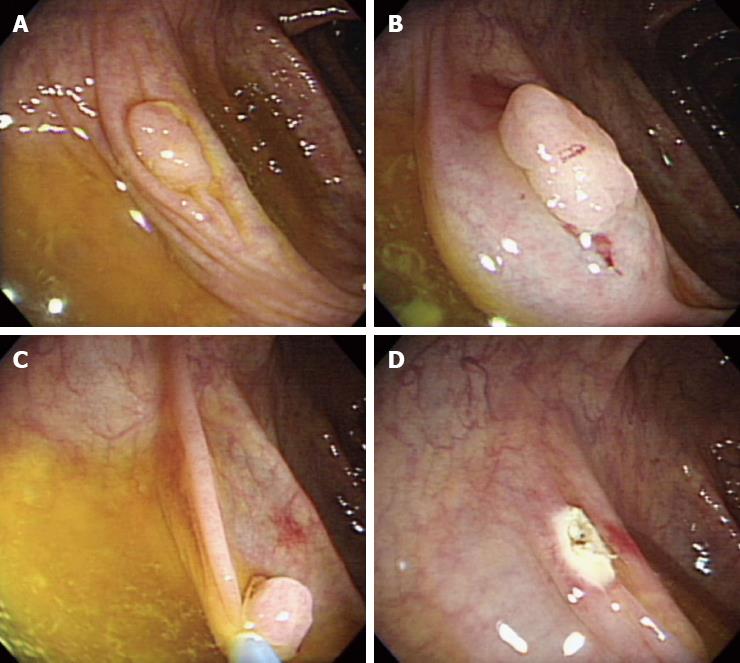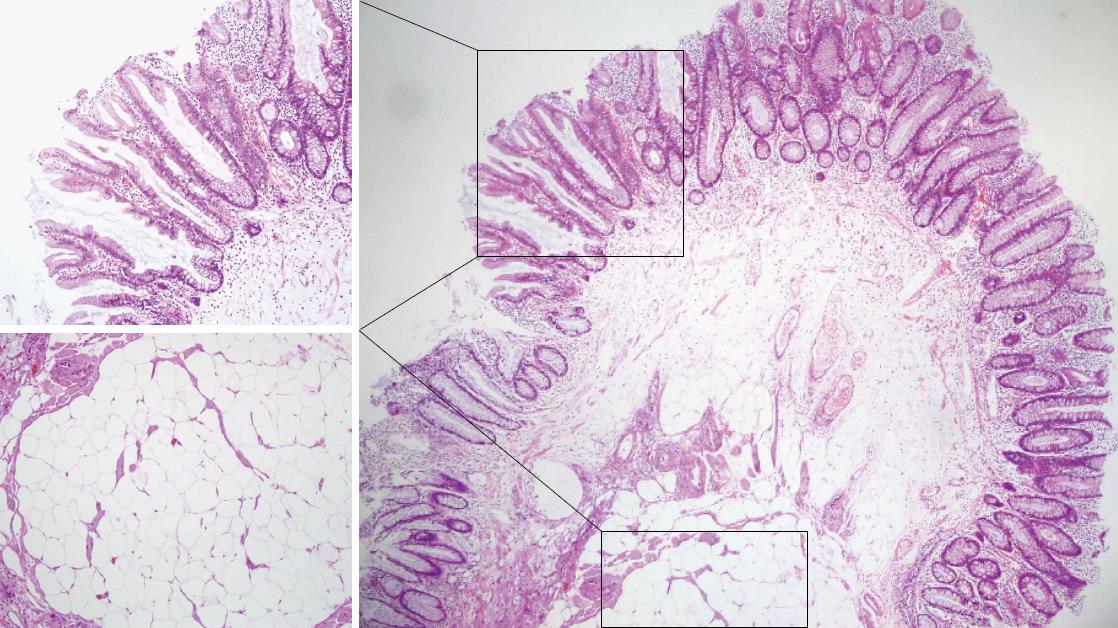INTRODUCTION
Lipomas are generally rare, but are the most common nonepithelial benign tumors of the gastrointestinal tract. Colonic lipomas are uncommon mesenchymal neoplasms, with a reported incidence of 0.2%-4.4%[1]. Colonic lipomas are usually asymptomatic and detected incidentally at colonoscopy, radiological investigation, surgery, or autopsy. The most common colonoscopic finding is a smooth, slightly yellow, spherical polyp, that is usually sessile and rarely pedunculated, with intact overlying mucosa[2]. In rare cases, the mucosa covering a lipoma shows alterations such as hyperplasia[3,4], atrophy[5], adenomatous changes[6,7], and necrosis and/or ulcerations[8-10]. We herein report a case of colonic lipoma covered with hyperplastic epithelium in a 68-year-old woman and review the literature pertaining to this condition.
CASE REPORT
A 68-year-old woman with abdominal discomfort for several weeks was referred to our department by a private internist for further investigation of a 9 mm polyp in the ascending colon that was revealed during a barium enema for the evaluation of symptom. She denied constipation, diarrhea, hematochezia, or melena. Her physical examination and medical history were unremarkable. All laboratory examinations, including complete peripheral blood cell counts, blood biochemistry, and carcinoembryonic antigen levels were within normal ranges. Colonoscopy revealed a sessile polyp about 9 mm in diameter in the ascending colon (Figure 1). We resected the polyp using a endoscopic mucosal resection (EMR) after a saline solution injection. No procedural-related complications were observed. A histopathological examination revealed a tumor composed of adipose tissue covered by hyperplastic and serrated epithelium consisting of columnar and goblet cells (Figure 2). The patient has been followed closely and has shown no recurrence. A follow-up colonoscopy revealed no remarkable findings 6 mo after the EMR.
Figure 1 Colonoscopy showing a sessile polyp located in the ascending colon (A), after saline was injected (B), endoscopic mucosal resection was performed (C and D).
Figure 2 Microscopic image of the resected specimen showing a colonic lipoma with overlying hyperplastic epithelium in the low-magnified image (hematoxylin-eosin, × 40).
The lining epithelium resembles a hyperplastic polyp and a tumor composed of adipose tissue in the high-magnified image (hematoxylin-eosin, × 100).
DISCUSSION
Colonic lipomas are benign, slow growing tumors of mesenchymal origin that rarely cause symptoms and are usually detected incidentally[1,11]. The most common sites of colonic lipomas are the cecum, ascending colon, and sigmoid colon, in decreasing frequency. These benign tumors arise from the submucosal layer in approximately 90% of cases and from the subserosal or intermucosal layer in the remaining cases[2]. Pathologically, lipomas are composed of well-circumscribed, mature adipose tissue with varying amounts of fibrous stroma covered with intact colonic mucosa[1,2,11].
Diagnostic tools for colonic lipomas include colonoscopy, computed tomography, barium enema, and endoscopic ultrasonography. Among these, colonoscopy allows direct visualization of a colonic lipoma. Lipomas are seen as smooth, slightly yellow, rounded polyps with a thick stalk or broad-based attachment[2]. Characteristic features include the “tenting sign” (grasping the overlying mucosa), the “pillow sign” (pressing forceps against the lesion results in depression or pillowing of the mass), and the “naked fat sign” (extrusion of yellowish fat after biopsy)[1,2,11]. The current case did not show these three characteristic features of a lipoma but the morphology of an epithelial lesion such as hyperplastic polyp or sessile serrated adenoma. The resected specimen was a submucosal lipoma and the covering epithelium was hyperplastic, resembling a hyperplastic polyp. The epithelium was serrated and comprised of both columnar and goblet cells, but lacking atypia or mitotic activity. To the best of our knowledge the association of lipoma and hyperplastic polyp has been reported only once. Radhi et al[3] showed a large lipoma in the sigmoid colon with overlying hyperplastic epithelium that was detected during an operation in a patient with diverticulitis. It was unclear whether the co-occurrence of these entities was coincidental or correlated. Hyperplastic polyps have been considered non-neoplastic lesions without malignant potential for many years. However, recent studies have shown that some hyperplastic polyps possess molecular features similar to those of colorectal carcinomas[12,13]. Several subtypes of serrated polyps, such as sessile serrated adenomas, traditional serrated adenomas, and mixed polyps, have been proposed to be colorectal carcinoma precursors. In addition to hyperplastic changes of the epithelium lining in a lipoma, rare cases of adenomatous transformation have been reported[6,7]. It is speculated that chronic trauma due to the passage of stools may lead to hyperplasia and adenomatous transformation of overlying mucosa[7]. In rare cases, the colonoscopy may reveal ulcerations, a finding that may lead to a mistaken diagnosis of adenocarcinoma[8-10].
Although most lipomas require no treatment, a small subgroup requires surgical intervention, including those with suspected malignancy, symptomatic lipomas, surgical emergencies such as intussusception, and obstruction with ulceration and bleeding[1,2,11]. Colonic lipomas < 2 cm can be safely removed endoscopically, whereas larger lesions should be removed by segmental resection[1,2,14]. In the present case, the polyp was initially suspected as a small epithelial lesion based on the colonoscopic findings and was resected endoscopically.
In conclusion, we report a rare case of a colonic lipoma with overlying hyperplastic epithelium. Removing an asymptomatic colonic lipoma is not necessary, as it may have no clinical significance. However, treatment plans for colonic lipomas might be reconsidered as transformation of the mucosa lining of a lipoma could occur in small and asymptomatic lesions.










